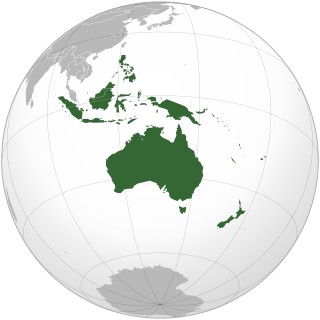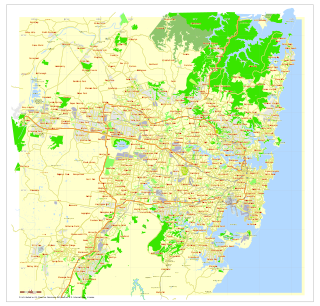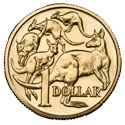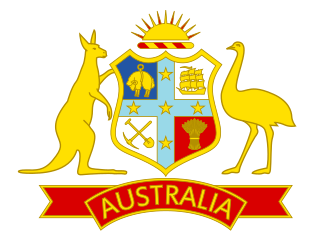The Australian Broadcasting Corporation (ABC) is Australia's national broadcaster founded in 1929. It is currently principally funded by direct grants from the Australian government, but is expressly independent of government and partisan politics. The ABC plays a leading role in journalistic independence and is fundamental in the history of broadcasting in Australia.

Oceania is a geographic region comprising Australasia, Melanesia, Micronesia and Polynesia. Spanning the eastern and western hemispheres, Oceania covers an area of 8,525,989 square kilometres (3,291,903 sq mi) and has a population of 40 million. Situated in the southeast of the Asia-Pacific region, Oceania, when compared to continental regions, is the smallest in land area and the second smallest in population after Antarctica.

Papua New Guinea, officially the Independent State of Papua New Guinea, is an Oceanian country that occupies the eastern half of the island of New Guinea and its offshore islands in Melanesia, a region of the southwestern Pacific Ocean north of Australia. Its capital, located along its southeastern coast, is Port Moresby. The western half of New Guinea forms the Indonesian provinces of Papua and West Papua.

Sydney is the state capital of New South Wales and the most populous city in Australia and Oceania. Located on Australia's east coast, the metropolis surrounds Port Jackson and extends about 70 km (43.5 mi) on its periphery towards the Blue Mountains to the west, Hawkesbury to the north, the Royal National Park to the south and Macarthur to the south-west. Sydney is made up of 658 suburbs, 40 local government areas and 15 contiguous regions. Residents of the city are known as "Sydneysiders". As of June 2017, Sydney's estimated metropolitan population was 5,131,326, and is home to approximately 65% of the state's population.

Tasmania is an island state of Australia. It is located 240 km (150 mi) to the south of the Australian mainland, separated by Bass Strait. The state encompasses the main island of Tasmania, the 26th-largest island in the world, and the surrounding 334 islands. The state has a population of around 526,700 as of March 2018. Just over forty percent of the population resides in the Greater Hobart precinct, which forms the metropolitan area of the state capital and largest city, Hobart.
The history of Australia is the history of the area and people of the Commonwealth of Australia with its preceding Indigenous and colonial societies. Aboriginal Australians arrived on the Australian mainland by sea from Maritime Southeast Asia between 40,000 and 70,000 years ago. The artistic, musical and spiritual traditions they established are among the longest surviving such traditions in human history
.

The Australian dollar is the currency of Australia, and of three independent Pacific Island states, specifically Kiribati, Nauru, and Tuvalu. It was introduced on 14 February 1966 when the pre-decimal Australian pound, with its system of shillings and pence, was replaced by the new decimal currency, the Australian dollar.

The Order of Australia is an order of chivalry established on 14 February 1975 by Elizabeth II, Queen of Australia, to recognise Australian citizens and other persons for achievement or meritorious service. Before the establishment of the order, Australian citizens received British honours.

Catherine Elise Blanchett, is an Australian actress and theatre director. She has received many accolades, including two Academy Awards, three Golden Globe Awards, and three BAFTA Awards. Time named her one of the 100 most influential people in the world in 2007, and in 2018, she was ranked among the highest-paid actresses in the world.

The Australia national cricket team is the joint oldest team in Test cricket history, having played in the first ever Test match in 1877. The team also plays One-Day International (ODI) and Twenty20 International (T20I) cricket, participating in both the first ODI, against England in the 1970–71 season and the first T20I, against New Zealand in the 2004–05 season, winning both games. The team draws its players from teams playing in the Australian domestic competitions – the Sheffield Shield, the Australian domestic limited-overs cricket tournament and the Big Bash League.

George Pell is an Australian prelate of the Catholic Church convicted of child sexual abuse. He served as the inaugural Prefect of the Secretariat for the Economy between 2014 and 2019; and was a member of the Council of Cardinal Advisers between 2013 and 2018. He previously served as the eighth Archbishop of Sydney (2001–2014), the seventh Archbishop of Melbourne (1996–2001) and an auxiliary bishop of Melbourne (1987–1996). He was created a cardinal in 2003. Ordained in 1966, he has also been an author, columnist, and public speaker. Since becoming Archbishop of Melbourne in 1996, he has maintained a high public profile on a wide range of issues, while retaining a strict adherence to Catholic orthodoxy on most matters. His views on the environment, and global warming in particular, are inconsistent with mainstream science, and contradict the positions held by Pope Francis.

Aboriginal Australian is a collective term for all the indigenous peoples from the Australian mainland and Tasmania. This group contains many separate cultures that have developed in the various environments of Australia for more than 50,000 years. These peoples have a broadly shared, though complex, genetic history, but it is only in the last two hundred years that they have been defined and started to self identify as a single group. The exact definition of the term Aboriginal Australian has changed over time and place, with the importance of family lineage, self identification and community acceptance all being of varying importance. In the past Aboriginal Australians also lived over large sections of the continental shelf and were isolated on many of the smaller offshore islands, once the land was inundated at the start of the inter-glacial. However, they are distinct from the Torres Strait Islander people, despite extensive cultural exchange.

The states and territories are the first-level administrative divisions of the Commonwealth of Australia. They are the second level of government in Australia, located between the federal and local government tiers.

Australia, officially the Commonwealth of Australia, is a sovereign country comprising the mainland of the Australian continent, the island of Tasmania and numerous smaller islands. It is the largest country in Oceania and the world's sixth-largest country by total area. The neighbouring countries are Papua New Guinea, Indonesia and East Timor to the north; the Solomon Islands and Vanuatu to the north-east; and New Zealand to the south-east. The population of 25 million is highly urbanised and heavily concentrated on the eastern seaboard. Australia's capital is Canberra, and its largest city is Sydney. The country's other major metropolitan areas are Melbourne, Brisbane, Perth and Adelaide.

The Australia national soccer team represents Australia in international men's soccer. Officially nicknamed the Socceroos, the team is controlled by the governing body for soccer in Australia, Football Federation Australia (FFA), which is currently a member of the Asian Football Confederation (AFC) and the regional ASEAN Football Federation (AFF) since leaving the Oceania Football Confederation (OFC) in 2006.
Indigenous Australians are the Aboriginal and Torres Strait Islander people of Australia, descended from groups that existed in Australia and surrounding islands before British colonisation. The time of arrival of the first Indigenous Australians is a matter of debate among researchers. The earliest conclusively human remains found in Australia are those of Mungo Man LM3 and Mungo Lady, which have been dated to around 50,000 years BP. Recent archaeological evidence from the analysis of charcoal and artefacts revealing human use suggests a date as early as 65,000 BP. Luminescence dating has suggested habitation in Arnhem Land as far back as 60,000 years BP. Genetic research has inferred a date of habitation as early as 80,000 years BP.
Other estimates have ranged up to 100,000 years and 125,000 years BP.

The continent of Australia, sometimes known in technical contexts by the names Sahul, Australinea or Meganesia to distinguish it from the country of Australia, consists of the land masses which sit on Australia's continental plate. This includes mainland Australia, Tasmania, and the island of New Guinea. Situated in the geographical region of Oceania, it is the smallest of the seven traditional continents in the English conception.

New Guinea is a large island separated by a shallow sea from the rest of the Australian continent. It is the world's second-largest, after Greenland, covering a land area of 785,753 km2 (303,381 sq mi), and the largest wholly or partly within the Southern Hemisphere and Oceania.


















